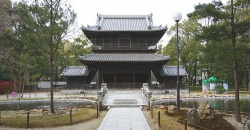Shofuku-ji
Shofukuji Temple is Japan’s oldest Zen temple, built by Zen master Yosai who returned from Sung Dynasty China in 1195. The large precinct houses the gate, butsuden Buddha hall, main hall and belfry, retaining the typical layout of a Zen temple. The wooden tablet on the gate was given by retired Emperor Gotoba and the inscription on it designates it as the first Zen temple of Japan. Yosai brought back tea leaves with him, giving rise to the tea culture of Hakata, which later spread to the rest of the country. The Hakata-bei, or wall, constructed during the reign of Toyotomi Hideyoshi in the 16th Century still stands there. The chief priest Sengai in the early 19th Century was a character who was known for his Zen paintings with deep meanings. The precinct with lush green is designated as a historical site of Japan.
Shofukuji Temple in Hakata-ku has the distinction of being Japan’s first Zen temple. The monk Eisai founded the temple in 1195 in order to spread the word of Zen, which he had learned in the southern Sung region of China. A framed inscription declaring Shofukuji as Japan’s first Zen temple hangs on the on the temple’s Sanmon Gate; it is said to have been written by Emperor Go-Toba.
Inside the spacious grounds, there are many lush trees as well as the prominent Sanmon Gate and Butsuden Hall. The perfect spot for a quiet stroll, the temple has become a popular site for tourists. Shofukuji’s Zen monastery is well preserved, but it is not open to the general public because it is still in use. The monastery houses several treasures .
Eisai also brought the custom of drinking tea from China to Japan. Tea drinking was widespread in China, and it was highly appreciated by Zen monks undergoing strict training because it was used as a medicine that was thought to reinvigorate the body. Eisai even wrote a manuscript called Treatise on Drinking Tea for Health, which describes the positive effects of tea.
It is said that Eisai brought tea trees from China and planted them on the grounds of Shofukuji and in the Sefuri Mountains. Even today, tea culture still plays an important role at Shofukuji, where an ancient style of tea ceremony called yotsugashira chakai is still practiced. Meanwhile, the nampo style of ceremony associated with the Kuroda Clan is still practiced at Enshoji, a sub-temple of Shofukuji.
